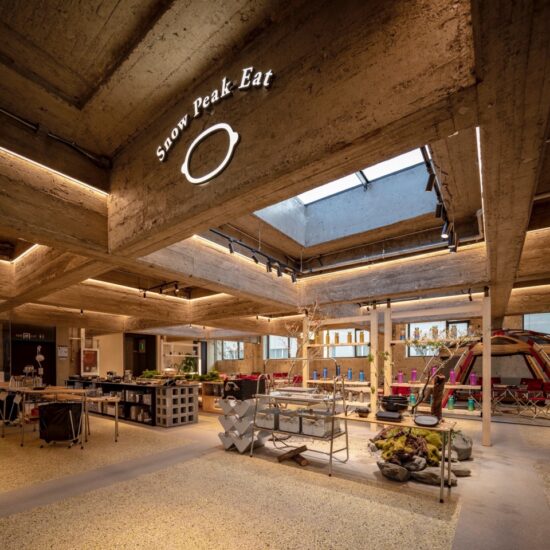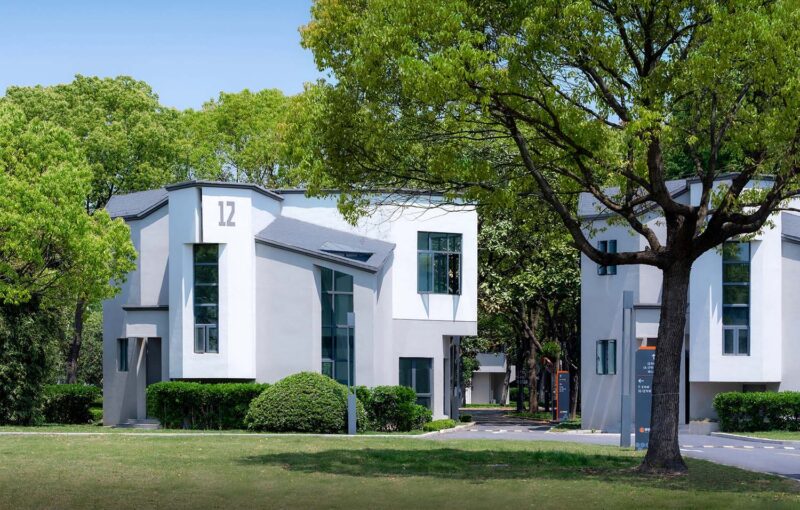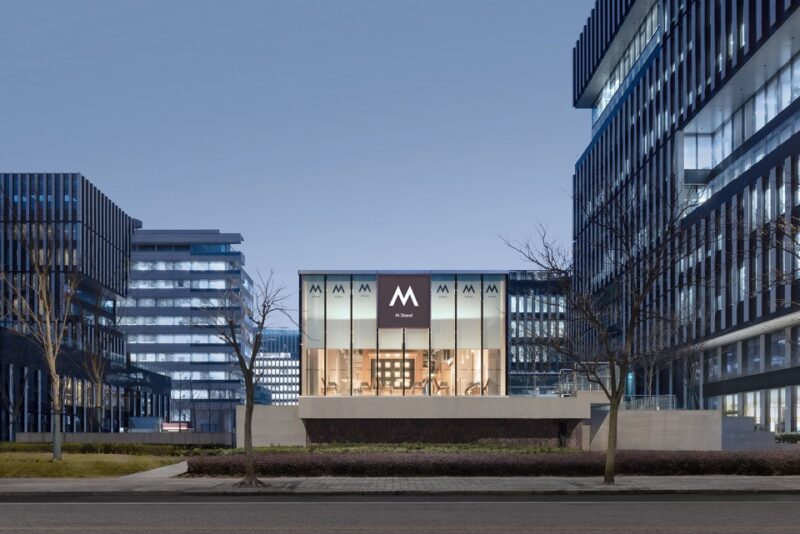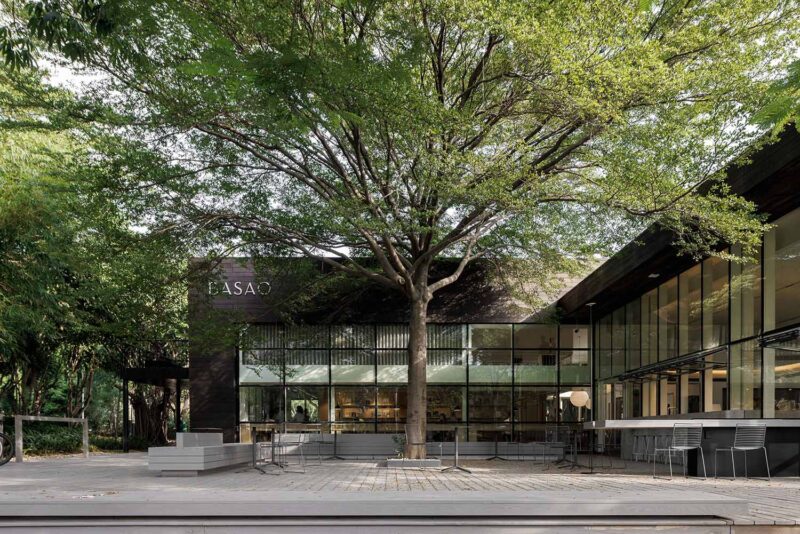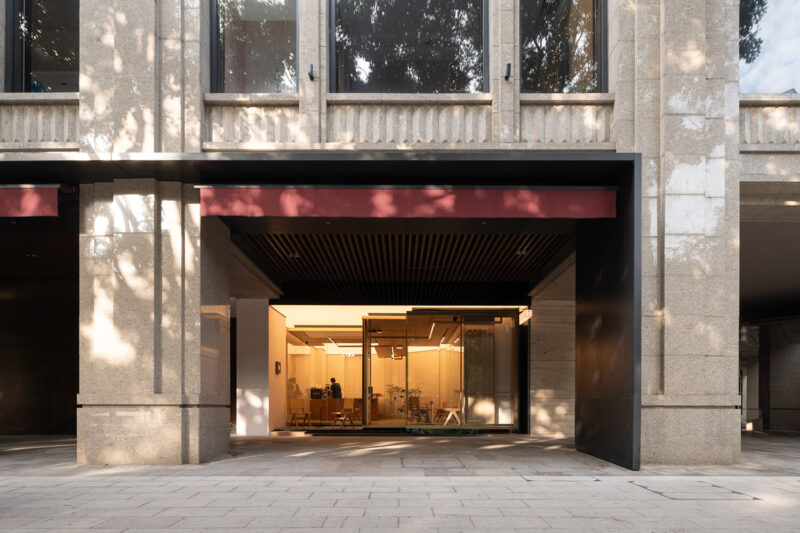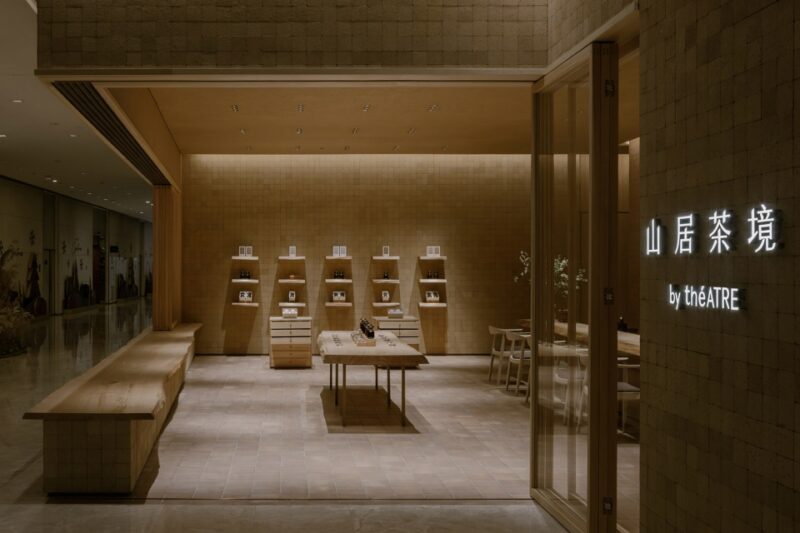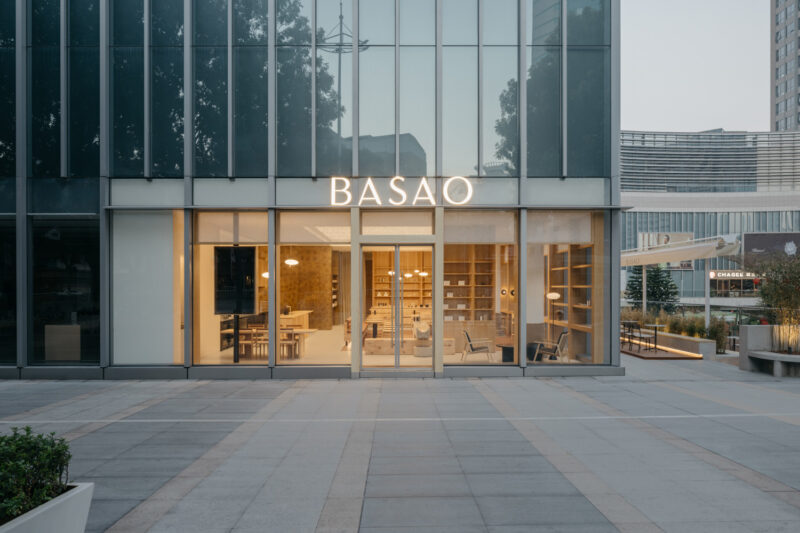四明山位于浙江省宁波市余姚市四明山镇,有龙虎山的气势壮观,兔耳岭的怪石灵秀,被誉为天然“氧吧”。杉野茶室坐落于山顶,作为基于原有茶山凉亭的建筑改造项目。
Siming Mountain is located in Siming Mountain Town, Yuyao City, Ningbo, Zhejiang Province. It has the magnificent momentum of Longhu Mountain and the exquisite strange stones of Tuerling. It is known as a natural “oxygen bar”. Sanyo Tea House is located on the top of the mountain and is a building renovation project based on the original tea mountain pavilion.
∇ 鸟瞰图,Bird’s-eye view © 徐英达
∇ 总平面图,Master plan© 徐英达
场地记忆,Site memory
首次到现场是一个四月阴雨天,从山下往山上走的路上我想到的是陶渊明在桃花源记中描述的场景“初极狭,才通人。复行数十步,豁然开朗”。
The first time I arrived at the scene was on a rainy day in April. As I walked up the road from the foot of the mountain, I thought of the scene described by Tao Yuanming in his work ‘Peach Blossom Spring’: ‘At first, the path was narrow and only allowed one person to pass through. After walking a few dozen steps, it suddenly opened up’.
既有建筑是由一个木构架的廊道和亭子组成的休憩配套建筑,且两个构筑不是同一时间建造的。场地面朝四明湖,背靠环山竹林,东侧和北侧的竹林给人很强的包裹感。在这样自然资源极为丰富的空间,我们和业主都认为该项目应建立与自然长期的链接,重新唤醒使用者对于自然的感知。基于对现场的空间感知,我们提出了两个重要的设计要点作为设计的切入点:微介入和观景。
The existing building is a recreational supporting structure consisting of a wooden corridor and pavilion, and the two structures were not built at the same time. The site faces the Siming Lake and is backed by a bamboo forest on the surrounding mountains. The bamboo forests on the east and north sides give a strong sense of enclosure. In such a space with abundant natural resources, both we and the client believe that the project should establish a long-term connection with nature and reawaken users’ perception of nature. Based on the spatial perception of the site, we propose two important design points as the starting point of the design: micro-intervention and landscape viewing.
意志载体, Spirit carrier
⼭是⼀座厨房,⼭脚、⼭⾥、树林间都有⻝材和⼯具。循环⾃⼭林的柴⽕需要被砍下,点燃,⽽不是煤⽓和⽡斯。柴⽕搭配慢煮,有着来⾃⼭的讯息:⽆需急躁,需要等待。等待⽣息,等待果蔬成熟,等待⾬⽔,等待阳光,时间到了,⼭会把它的丰盈呈现给你。
The mountain is a kitchen, with ingredients and tools at the foot of the mountain, in the mountains, and among the trees. The firewood from the self-sustaining forest needs to be chopped down and ignited, instead of using coal gas and electricity. The firewood, combined with slow cooking, carries a message from the mountain: there is no need to be impatient, but to wait. Wait for breathing, wait for fruits and vegetables to ripen, wait for rainwater, wait for sunlight. When the time comes, the mountain will present its abundance to you.
山系这一主题实际上是一个非常具有中国特色的命题。山系代表了中国传统人文情感的集中体现——追求避世之境。尽管在西方也存在隐士文化,但所谓的西方归隐是回归到原初状态,而中国的避世状态是身体虽远离尘嚣,但内心却追求更高层次的文化追求。这种状态很难以物质形式呈现,就如同王阳明所提到的“格物致知”:人性是无法改变的,而“意”与“行”之间存在着内在的联系。中国传统人文情感的核心思想或许就是追求这样的境界。因此,我们的愿景是在满足茶室基本功能需求的基础上,尽量简化并减少人们对物理空间的依赖,为使用者留出更多未被界定的、与自然融为一体的空间。这一点至关重要。因此,对环境的尊重与顺应成为我们方案的主要设计导向。山系茶室成为了人们进行“格物”的场所,这也正是我们建造它的初衷。
The theme of mountain range is actually a proposition with very Chinese characteristics. Mountain range represents the concentrated embodiment of traditional Chinese humanistic emotions – the pursuit of a secluded environment. Although there is also a hermit culture in the West, the so-called Western retreat is a return to the original state, while the Chinese state of seclusion is physically far from the hustle and bustle, but internally pursuing higher-level cultural pursuits. This state is difficult to present in material form, just like Wang Yangming mentioned in ‘Investigating Things and Extending Knowledge’: human nature cannot be changed, and there is an inherent connection between ‘intention’ and ‘action’. The core idea of traditional Chinese humanistic emotions may be to pursue such a realm. Therefore, our vision is to simplify and reduce people’s dependence on physical space as much as possible on the basis of meeting the basic functional needs of the tea room, leaving more undefined space integrated with nature for users. This is crucial. Therefore, respect for and compliance with the environment become the main design orientation of our plan. The mountain range tea room has become a place for people to ‘investigate things’, which is also the original intention of building it.
∇ 爆炸图,Exploded view © 平介设计
∇ 山顶远看,View from the top of mountain © 徐英达
建筑转译, Architecture translation
茶室中最引人注目的特点之一,便是朝向四明湖的一整片长条形折叠窗,占据了整整一面墙壁,犹如一个独特的取景框。在宜人的天气里,这横向折叠窗可以完全敞开,让客人尽情欣赏美不胜收的景色,随时享受微风拂面的宜人感觉。
One of the most striking features of the tea room is a long strip of folding windows facing Siming Lake, occupying an entire wall like a unique frame. In pleasant weather, these horizontally folding windows can be fully opened, allowing guests to enjoy the breathtaking scenery and the pleasant feeling of the breeze on their faces at any time.
∇ 朝内山看,Look at the mountain © 徐英达
∇ 朝外湖看,Look at the lake © 徐英达
∇ 金属置物架,Metal Shelf © 徐英达
建筑的感受源于多个方面,包括空间、光影、材质、以及体验等,这些元素共同构成了建筑的整体表现。在材质之间的相互交融中,不仅包括颜色和光影的相互影响,还包括触感上的材质质感。在建筑过程中,当水泥地面初次浇筑完成时,我曾觉得有一些违和,因为这种材质的厚重和粗糙感在整个空间中显得有些突兀。然而,我决定继续施工并观察发展,当墙面采用微水泥和不锈钢吧台完成时,我再次看向那块仿古涂料的水泥地面,此时,它的粗糙纹理却似乎融入得很自然,材料的层次感反而显现出来。
The perception of architecture comes from various aspects, including space, light and shadow, materials, and experience, which together constitute the overall expression of the building. The interplay between materials not only involves the mutual influence of color and light and shadow, but also the tactile texture of materials. During the construction process, when the cement floor was first poured, I felt a sense of disharmony because the heaviness and roughness of this material seemed somewhat abrupt in the entire space. However, I decided to continue the construction and observe the development. When the walls were finished with micro-cement and stainless steel countertops, I looked back at that piece of antique-coated cement floor. At this point, its rough texture seemed to blend in naturally, and the layering of materials became apparent.
∇ 入口处景色,View from the entrance © 徐英达
∇ 金属、木头、水泥材料的碰撞,Collision of metal, wood and concrete © 徐英达
∇ 金属、木头、水泥材料的碰撞,Collision of metal, wood and concrete © 徐英达
基于生态保护和修复的自然理念,室内外的家具、门和置物架均采用了当地的竹木材料进行现场制作。当阳光投射在这些风化后的老木材上时,展现出了特别自然的纹理和生动的颜色。在细腻和粗犷之间需要取得一种平衡,过于密集的细节可能让人感到不适,而过于粗糙的表面则可能显得简陋。因此,精确把握这种度和关系非常重要,同时,建筑师的个人感受也是关键因素,因为他们的每个决策都将影响建筑完成后的整体氛围。
Based on the concept of ecological protection and restoration, furniture, doors, and shelves indoors and outdoors are all made on-site using local bamboo and wood materials. When sunlight shines on these weathered old woods, they exhibit a particularly natural texture and vivid colors. A balance needs to be struck between delicacy and roughness, as overly dense details may make people uncomfortable, while overly rough surfaces may appear crude. Therefore, it is crucial to accurately grasp this degree and relationship. At the same time, the architect’s personal perception is also a key factor, as each of their decisions will affect the overall atmosphere of the building after completion.
∇ 外摆细节,Exterior detail © 徐英达
∇ 竹木家具,Bamboo and wood furniture © 徐英达
保留了原场地不规则矩形的地基,将部分室外草坪置于室内。
The irregularly rectangular foundation of the original site was retained, and a portion of the outdoor lawn was placed indoors.
∇ 保留原场地景观,Retained the original landscape © 徐英达
∇ 杯托细节,Cup holder detail © 徐英达
我们设计了不同高度的座位,当人的身体和视线随着座位方式的改变而发生变化时,惊喜会不间断的产生,人们从窗口中看到的景观也会变得丰富和多样。当你在不经意中发现这些观看角度的时候,这种趣味性就产生了。
We have designed seats of different heights, so that surprises will continuously occur as people’s bodies and lines of sight change with the changing seating arrangements. The landscapes seen from the windows will also become rich and diverse. This playfulness arises when you inadvertently discover these viewing angles.
顺应杨梅园的自然地理形态,采用嵌入的方法在室外塑造出几块露天营业区,通过砌筑挡土墙、铺灰色砂砾石、使用原木加工的桌椅等方法来弱化这一片区对自然的入侵感,与周遭环境融为一体。
In accordance with the natural geographical features of the Yangmei Garden, several open-air business areas are created outdoors using an embedded approach. This is achieved by constructing retaining walls, paving with gray gravel, and using wooden furniture to weaken the sense of intrusion on nature in this area, blending it harmoniously with the surrounding environment.
∇ 外部细节,Exterior detail © 杨楠
∇ 外部细节,Exterior detail © 杨楠
∇ 山顶远看夜景,Nightscape from the top of mountain © 徐英达
∇ 从室外东侧看向室内,View from the east side of the exterior looking into the interior © 徐英达
∇ 从室外西侧看向室内,View from the west side of the exterior looking into the interior © 徐英达
∇ 从东侧草坪看向室内,View from the east lawn looking indoors © 徐英达
与周围环境的互动在任何建筑中都具有极其重要的意义。环境本身有其独特的氛围,不同的周边环境会赋予建筑以不同的特质。忽视周边环境而建造的建筑只能算作满足使用需求的产品,而无法展现出多样性和生动性。在丰富多彩的环境中从事建筑设计令人欣喜,周边的街道、树木、村落、竹林、山脉等等,都应该被纳入建筑设计的考虑之中,以创造出充满生气和多样表情的建筑。正如有句话说:“桥上的人在看风景,看风景的人在楼上看你”,事物之间相互依存、相互关联,这才使生活充满了诗意。站在山下远眺茶室,茶室本身成为了一道风景,同时在茶室内,人们可以尽情欣赏四明山和四明湖的美景。人与人之间保持着一定的距离,但通过观察与被观察,空间的表达中融入了这种微妙的联系,这也增添了趣味和情感层次。
The interaction with the surrounding environment is of utmost importance in any building. The environment itself has its unique atmosphere, and different surroundings give buildings different characteristics. Buildings that ignore the surrounding environment can only be considered as products that meet functional needs, without showcasing diversity and vitality. Engaging in architectural design in a rich and colorful environment is delightful. The surrounding streets, trees, villages, bamboo forests, mountains, etc. should all be taken into consideration in architectural design to create buildings that are vibrant and diverse. As the saying goes, ‘People on the bridge are enjoying the scenery, while people in the building are being watched.’ Things depend on and relate to each other, making life poetic. Standing at the foot of the mountain and looking at the tea house, the tea house itself becomes a scenery, and at the same time, people inside the tea house can fully appreciate the beautiful views of Siming Mountain and Siming Lake.There is a certain distance between people, but through observation and being observed, this subtle connection is integrated into the expression of space, adding interest and emotional depth.
∇ 从内山看向建筑,View of the building from the inner mountain © 徐英达
∇ 从内山看向建筑,View of the building from the inner mountain © 徐英达
∇ 从山下看向建筑,View of the building from the bottom of the mountain © 李栽培
∇ 不同取景,Different views in the building © 李栽培
∇ 手工模型,Manual model © 平介设计
∇ 剖面图,Section drawing © 平介设计
∇ 总平面图,Site plan © 平介设计
∇ 首层平面图,Ground plan © 平介设计
项目信息
项目名称:四明山麓的杉野茶咖
项目类型:建筑改造
设计方:平介设计
公司网站:www.parallect-design.com
联系邮箱:info@parallect-design.com
项目设计:2023.4
完成年份:2023.10
设计团队:吴江,杨楠,肖湘东
项目地址:浙江省余姚市梁弄镇横路村
建筑面积:150㎡
摄影版权:徐英达、李栽培、杨楠
合作方:上海衡泰建筑设计咨询有限公司、浙江汇达装饰工程有限公司
客户:杉野计划、跃界品牌咨询
材料:铝镁锰板、硅酸钙板、微水泥、折叠移窗
品牌:杭州锋凡新材料有限公司、广东顺德漆彩嘉建材有限公司、湖南长乐建材有限公司、麦韦德门窗































